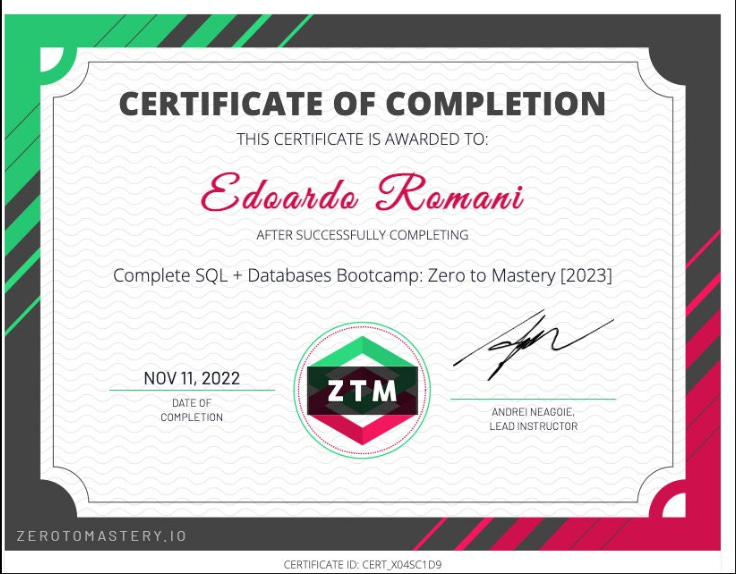What I learned from Zero to Mastery’s 26-hour SQL Bootcamp
A review from a Zero to Mastery Bootcamp student
A review from a Zero to Mastery Bootcamp student

(Notes: All opinions are my own)
Introduction
In the past month, I have managed to complete the Complete SQL + Databases Bootcamp: Zero to Mastery [2023] offered by Zero to Mastery Academy, one of the best platforms to learn software development I’ve recently bumped into.
The course itself represents approximately a total of 26 hours of coursework, as stated by the website itself, and it focuses on PostgresSQL.
I have just started to use the platform as I plan to continue to develop as well as refresh my technical skills, and I look forward to moving on to other courses, such as the Complete Python Developer in 2023: Zero to Mastery and more.
I used the course to get exposure to the more advanced aspects of SQL, given I was not new to the topic and have been writing other articles around it, such as the below:
5 Beginner to Advanced T-SQL interview questions for Data Analysts
A FinTech Startup’s case study with sample data and SQL Server implementation in SSMSmedium.com
7 Beginner to Intermediate SQL Interview Questions for Data Analytics roles
With sample data and MYSQL implementation on goormIDEtowardsdatascience.com
In this article, I take an overall look at this course and expand on three specific aspects I think make it a great SQL learning resource you may want to consider.
If you’re looking for general tips to stay consistent through completion while learning on DataCamp or similar online resources, check out another article of mine that approaches that specific theme:
How to actually finish Data Science online courses: 8 completion tips
Practical advice on reaching the finish line without distractionstowardsdatascience.com
This said, let’s dive right in!
Advanced SQL
The course is deep in knowledge and it features a fantastic Advanced SQL section full of great explanations, examples, and hands-on exercises around more advanced SQL topics such as the following:
GROUP BY, HAVING, and GROUPING SETS
WINDOW FUNCTIONS, PARTITIONING, FIRST_VALUE, LAST_VALUE, ROW_NUMBER
CONDITIONAL STATEMENTS
NULL AND NULLIF
Creating and working with VIEWS
INDEXES and Indexing algorithms
SUBQUERIES
Each of the above topics is unpacked in great detail to the extent that the learner understands the WHY behind the syntax and not just the HOW. Many useful exercises on each topic are used to reinforce your learning.
The highlight of the section for me was window functions, which are explained in great detail with example after example that make knowledge stick. Andrei, the Instructor, does a great job at making the topics easy and tangible, and he conveys the meaning behind each query he uses very well.
Database Management
Most SQL courses only focus on the mere SQL syntax; this one does not and goes an extra step, or even two, by taking you to grasp the full picture that comes with managing databases.
The course dedicates an entire section to this critical topic, exposing the following aspects of Database Management
Types of Databases in an RDBMS
Database Templates
Database Creation
Databases Organization
Roles, Attributes, and Users
Privileges
Data Types
Data Models
Table and Column Constraints
Backup and Restore
Even if you are taking this course to purely focus on your SQL skills, this section is gold because it gets the student exposure to the Database Administration side of things and enriches the learning experience with much-needed context.
In addition, the above topics are pertinent in the general realm of computer science, cloud computing, and information technology, and the principles won’t necessarily change as you change the technology you choose to study next, so getting a great overview of these here is a bonus and fits the flow of the course’s curriculum nicely, since it complements the prior sections which instead get you to write SQL queries.
Database Design
The course does conclude on a high note by also getting the student to reason at an even higher level than Database Management, which is the topic of Database Design.
This section is a gem and gets the student to understand the overall decision flow that goes into creating and mapping out a database solution using two different approaches, bottom-up and top-down.
The key topics covered in this section are:
System Design and Software Development Life Cycle (SDLC)
Top-Down vs Bottom-Up Design
Entity Relationship Models
Relational Schemas and Instances
Keys
Normalization and Anomalies
Functional Dependencies
The Normal forms
These topics are great because through them you’ll get the full picture of what goes into the decisions of even coming up with a need for a Database and how to design it appropriately in the first phase.
Beyond just great SQL teaching, this and the prior section were my favorites.
Summary and next steps
Overall, I cannot recommend the Complete SQL + Databases Bootcamp: Zero to Mastery [2023] course by Zero To Mastery Academy enough, especially as you are starting on your software developer learning journey.
To summarize how you get the best out of the course as well as your overall learning experience, remember to:
Put hands-on practice time to sharpen your Advanced SQL skills
Wear the hat of a Database Administrator and Database Designer
Enjoy the bonus section on the Big Data landscape, different Database Technologies, and more!
Enjoy the ride, and thanks for reading!
Sign Up for Zero to Mastery Academy
Join Medium with my referral link — Edoardo Romani
As a Medium member, a portion of your membership fee goes to writers you read, and you get full access to every story…edo-romani1.medium.com
*Disclaimer: This post may contain affiliate links which means that I may earn a small commission at no additional cost to you)


